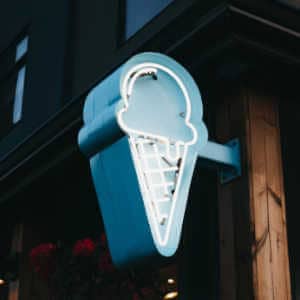What are the challenges in an ice cream business? Starting any small business, let alone a fun one like ice cream, has its challenges. According to the Bureau of Labor Statistics, 20 percent of small businesses fail in their first year. Nearly 50 percent of fail within the first five years. The odds are against you. But, you are not like any other business. You are starting an ice cream business. So, what exactly are the challenges specific to ice cream businesses? Having owned an ice cream shop, an ice cream truck, and sold wholesale ice cream pints, I have a good understanding of the challenges you will face. In this post, I want to share with you exactly what those are. I will divide this post into specific challenges facing: (1) ice cream shops; (2) ice cream trucks; and (3) wholesale grocery pints.
To begin with, what are the main challenges in an ice cream business?
The Main Challenges in an Ice Cream Business
As a general rule, the main challenges in the ice cream business are:
- For Ice Cream Shops
- Management
- Winter
- Locational Limitations
- Startup Costs
- Soft Serve vs Scooping
- Creating a Strong USP
- Ice Cream Trucks
- Truck Repairs
- Regularity of Events
- Parking Spots
- Wholesale
- Margins
- Barriers To Entry
- Production and Distribution
- Marketing

Challenges for Ice Cream Shops
Why Do Ice Cream Shops Fail?
In my six years of owning and managing an ice cream shop, these are what I have observed as the six biggest reasons why ice cream shops fail.
1. Employees and Management
An Ice cream shop needs a manager as much as a restaurant does. However, the big difference between ice cream shops and restaurants is that restaurants have much higher ticket values. This is the total amount of money you make per sale.
The result is that a restaurant can generate more revenue per sale than an ice cream shop. For example, in my ice cream shop, my average $ sale value is around $11 to $14. This is the average sale I make per order.
Compared to a restaurant this is considerably lower. For a restaurant, I would expect this figure to be $50 + (depending on the type of restaurant). This means that a restaurant can afford to find and pay a manager. A lot of independent ice cream shops won’t have the revenue to be able to pay a good manager.
You Will Likely Be The Manager Of Your Ice Cream Business
Whilst an ice cream shop is not as complicated as a full-scale restaurant, it still will require active management. You will not be able to pay someone minimum wage and then expect them to run the ship without any management.
A lot of independent ice cream shops are owner-managed (like mine). This means you will be on call for everything.
- A team member can’t find cups.
- Wait, what was that – we are out of chocolate chips.
- Hold on, the AC is not working?
- There is a homeless man sitting outside – what should I do?
- The freezer has stopped working?
- There is a power cut – what should I do?
These are all situations I have had to deal with.
Being an active manager is not a bad thing – I think it can be one of the reasons you can make your ice cream shop a success. But, burnout, wanting to take regular holidays, and not having your phone on loud constantly in case an employee calls with a question – are all real issues at owner-managed ice cream shops. However, you can improve these by better training and organizing your ice cream store.
Leaner Employee Structure
Ice cream shops will tend to operate on a leaner employment structure. This is especially the case when compared to restaurants. For example, at my ice cream shop, I try and operate one person at a time in the store (on occasions two).
The challenge is that in a restaurant if one server calls in sick then the restaurant can usually still make the shift work. Each server may just have to do more. There are more employees to call on in a restaurant.
In my ice cream shop, if my team member opening Monday calls in sick Monday morning then it is an issue. I am less likely to find last-minute cover and will often have to cover the shift myself. In fact, at the time of writing this (Saturday morning), my Saturday evening team member texted to say they were sick. This then threw the whole day into disarray as I tried to find cover.

How To Solve Management and Staffing Challenges
Solving Management Challenges
When it comes to Management challenges, I find the best approach is four things:
- Know everything about your business.
- Have contingencies in place – (a spare set of keys, a credit card for team members to be able to buy any last-minute items, suppliers who can deliver last minute).
- Develop an excellent training program – creative videos or checklists for every part of your business. If a team member doesn’t know how to do something have all the videos and training saved on a tablet in the store team members. Don’t create a long employee manual (I did this, and it just became a big paperweight). Short checklists, videos, and FAQs all on a tablet you can remotely update are the best.
- Organize your store. There should be a specific place for everything in the store. Be strict about it. Don’t let anything move from its dedicated spot. Label everything.
Solving Staffing Challenges
When it comes to staff challenges the best option is to have large numbers of employees on the payroll. A larger number of employees with 2 -3 shifts each a week. This way when cancellations happen you have more employees to call on. You also avoid team burnout.
In the past, when I have had fewer employees doing more shifts, cancellations have proved much harder to manage. Accept there will be occasions you will have to cover a shift at your ice cream shop. Use it as an opportunity to learn something about your business and improve it.
Last, it goes without saying that you should hire only excellent people. I focus on hiring college students who have a lot of drive. If you make a bad hire, accept it, and remove them from the business.

2. Winter
Winter. It will happen once every year for the rest of your life. It also affects ice cream business sales no matter where you are.
I started my ice cream shop in Los Angeles where I thought seasonality wouldn’t be an issue. I was wrong. My first winter was a complete and utter shock. Sales halved compared to the summer months.
Halved!
The thing about winter is that it is relative to where you are. Yes, 60 degrees Fahrenheit isn’t that cold, but it is cold when you are used to temperatures in the 90s for most of the time.
Sell Different Things During the Winter
How about trying to sell coffee or other things during the winter months?
I have tried selling hot chocolate, ice cream pies, and all sorts of more “wintery” offerings in my ice cream stores. However, I just found that these items never really helped during the winter months.
Customers who came in during the winter were coming in because they wanted our ice cream. If they wanted hot chocolate they would go to a coffee shop, like a Starbucks. You see it becomes hard to position yourself as an ice cream/coffee store. The two just don’t seem confusing together. They are different items, working different typical hours, etc. And then what are you really known for coffee or ice cream?

How To Solve Winter Seasonality
What’s the best way of combating winter seasonality? Three things: (1) make the best ice cream you can; (2) develop special winter flavors; and (3) operate with a leaner staff structure.
Making the best ice cream you can
Let’s take “making the best ice cream you can” – if you make amazing ice cream and become known for the best type of ice cream in your area people will still want to come in the winter months. Yes, sales will lower in the winter, but it won’t be as bad.
Winter Flavors
As for winter flavors. Come up with a winter flavor plan. Think Pumpkin Spice, Peppermint Chocolate, Candy Cane, Cinnamon, Thin Mint, Eggnog, Gingerbread, Cherry Pie, or Pumpkin Pie, instead of more summer flavors like refreshing sorbets.
People want these types of flavors in the winter and will come in specifically for them. My strategy for winter flavors is to offer one new winter flavor each week from October to the end of December. Don’t launch them all at once. Introduce one each week and rotate it together with your regular flavors.
Leaner Staff
From an operational point of view, you may want to think about a leaner staff structure in the Winter. This will help reduce your overheads. Just remember, your shop still needs to be manned when open so there is only so much you can reduce staffing in the Winter.
The more important thing is to understand that you will need to allocate some of your summer cash flow to the winter months just in case.
3. Poor Location
Location, location, location. If you don’t realize the importance of location, then you shouldn’t even be thinking of starting an ice cream shop. It is the biggest decision you will have to make.
The Ideal Ice Cream Shop Location
The ideal ice cream shop location involves a location with great visibility, high footfall (and the right type of footfall) all year round, easy parking, and all at a great cheap rent. That doesn’t exist everywhere.
Also, the better your location the higher your rent is going to be.
Rent for ice cream shops is a challenge. When you are selling $5 ticket items there is only so high you can go with rent. That means you want the right space – nothing bigger than you absolutely need. One of the great things about ice cream is that you do not need customer seating.
My First Location
When I picked my first ice cream shop location, I chose a 400 sq foot (the team restroom was 50 square feet) in a very affluent area. It had good footfall (for Los Angeles) and parking in the rear. It was also directly opposite a frozen yogurt chain. Literally, it was across the road from me. Right opposite.
Did having an established frozen yogurt store across the street affect us? No. It didn’t affect us at all.
The biggest challenge to my first location was that we were slightly set back from the sidewalk in the middle of a building complex. It sounds like a trivial thing, but you wouldn’t believe how much people don’t notice when they are walking down a street.
How to Pick A Great Location
When it comes to location you have to become the pickiest person in the world. If you are a new startup without any customer following yet this is particularly important. You want something that makes you as visible and accessible as possible.
Pick only as big as you strictly need to operate. My front-of-house area is about 100sq feet. Don’t pay extra for space you don’t need. You are an ice cream business not a restaurant. Calculate how much you must sell per square foot. Selling over $1,000 (from 1 pm to 10 pm daily) is busier than you expect.
Lastly, I wouldn’t factor competition too much into the mix. We have had many competitors open and close to our ice cream shop and it hasn’t impacted us in the long run. Even the yogurt shop right opposite our shop hasn’t impacted us in the long run. If your product is unique and special enough, it won’t matter. Remember there is always room for the best.

4. Costs And Permitting Issues for Opening An Ice Cream Shop
If you want to open an ice cream shop in the USA you need to think about the challenges with permitting. How challenging are your local health and building departments? Often the two are separate departments with separate requirements. Pleasing one does not always please the other. Dealing with questions, queries, and requirements will also take time and money. Ultimately delay your launch time.
When I opened my first ice cream shop, I was required to build things I wasn’t expecting. For example, extra walls or digging up the whole floor for an extra pipe.
These extra requirements can really add up and drag out the building process. Don’t believe me? Take a look at this store of someone who spent $200,000 trying to open an ice cream shop in San Francisco only for it not to happen. Sadly, this isn’t the first time I have heard of an ice cream venture not even managing to open its doors.
Timeframes to Launching
Whatever you plan for launching double it. It took me over 10 months from signing our ice cream shop lease to opening our doors. It also cost $180k, which was more than I was expecting. Also during this time, our landlord was pushing us to start paying rent.
It felt like an age, but the funny thing was once we opened several local restaurateurs came into our shop and asked how we managed to open so quickly.

How to Solve Challenges with Permitting and Opening
How do you solve permitting and opening challenges? The first is that you need to become an expert in the local planning and health codes. Find people who have experience in dealing with the relevant planning and health departments. Make sure you understand the rules and regularly follow up on the process. Don’t rely on other people to do it for you.
Lastly, whatever your budget and timeline are for opening – double both.
5. The Challenges of Soft Serve vs Scooping
In this section, I want to talk about the serving format. In the ice cream business, there are two ways of serving ice cream: (1) as soft serve via a soft-serve machine, or (2) as traditional scoops.
Soft Serve
I am going to use this section to vent a little bit about Soft Serve. As you will learn I am not a fan.
When I first opened my first ice cream shop six years ago, I just served soft serve. Pinkberry was all the hype still and I wanted to do a different take on Soft Serve. I also thought Soft Serve would be better than scooping. The machine constantly produced soft serve and serving was a lot easier. Right?!
Wrong.
Let me tell you Soft Serve is hard and frankly a complete and utter pain. I’ll write a dedicated post on operating a soft-serve business. Here are just a few of the challenges of soft serve:
Soft Serve Machines Are Unreliable
It doesn’t matter what brand you buy, Soft Serve machines are unreliable. Getting them to run smoothly for a period using anything but pre-made chemical-filled products is a miracle.
Any type of blockage during any busy period or overuse and the soft serve machine will hard freeze. The product will stop coming out and the machine will potentially break somewhere. Soft serve machines are delicate creatures that need a lot of love and attention during a shift. During busier periods you will need someone dedicated to watching over them. Why do you think frozen yogurt stores have so many of them?
I have lost count of the number of times I have had to repair a Soft Serve machine. Yes, me – because the repair person didn’t know how to do it. I taught myself. It was quicker and cheaper.
Swirling From Soft Serve Machines
Swirling from a soft-serve machine is a skill you need to learn. Producing a decent-looking swirl takes time and practice.
When I started my business just sold soft serve. It would take forever and a whole load of wasted soft serve to train people how to swirl.
Separately getting portions uniform is nearly impossible. As a result, often twice as much is given out in a single portion affecting your margins. Even more so if you are making your own bespoke soft serve mix – as I was.
Hard scooping in comparison – simple, easy, and effective.
Cost of Soft Serve Machine
Soft Serve Machines cost a lot. I chose a reputable and solid brand and two machines cost me $27,000. Two machines that could only offer 4 flavors.
In comparison, when I decided to ditch soft serve and move to scoops, I bought a $7,500 used Emery Thompson machine. The best on the market. To date, this machine is still going and has produced over a million dollars worth of ice cream in varieties of flavors. It is also simple to train people on, operate, and clean.
Limited Flavors
On a soft-serve machine, your flavors are limited to the number of slots on the machine. Typically, a soft-serve machine will have 2 slots and one mix. That means the number of flavors you can offer is limited by how many soft serve machines there are. Want 10 flavors you will need 5 soft serve machines – that is about $50,000+.
In comparison, how many flavors can you have with a batch of freezer-making scooped ice cream? As many flavors as you can store in your scooping freezer.
Cleaning Soft Serve machines
Cleaning soft serve machines is time-consuming and expensive.
Let me put this into context. Soft serve machines have many parts. All must be washed, cleaned, and sanitized regularly. I was genuinely taken aback the first time we washed our machines. It would take me at least one hour to clean one machine.
You have five machines – that’s 5 hours of cleaning. That is before putting them back together.
This process needs to occur several times a week (or even potentially daily depending on health department guidelines where you live). If you live somewhere with a high minimum wage this can really impact your bottom line.
Adds In
You can’t mix in add-ins to soft serve. Do you have visions of offering Ben and Jerry-style flavors with chunks mixed through? Well, you can forget about it with a soft serve machine.
I have even known a few raspberry seeds to wreak havoc on a soft serve machine. The product you pour into a soft serve machine needs to be completely smooth and free of any pieces.
I remember in the early days of our ice cream shop a former soft serve owner came into our shop. She recanted to us about the nightmares she still had about soft serve machines. A conversation about exploding soft serve machines and having to pay for customers’ dry cleaning bills ensued.
Seeing soft serve machines now send shivers down my spine.

How to Solve the Challenge of Soft Serve Machines?
In the process of starting an ice cream business and debating whether to do soft serve, scoops, or both – go with the scoops. It will save you so much hassle in the long run.
I ended up having so many issues with our soft serve machines that I sold them and switched to scoops. I sold them for a fraction of what we paid for them (think 20%). It was the best decision I ever made. Since then, our sales have over doubled. I honestly don’t think our ice cream shop would still be in business had we not ditched the soft serve machines and moved to scoops.
6. An Ice Cream Shop Has To Offer Ice Cream With A Strong USP to Stand A Chance of Success
Unique Selling Point (USP). Read any business startup book and it is a term you come across. What does it mean? For starting an ice cream business, it means your ice cream better be:
- unique
- special
- can’t be bought somewhere else, and
- something people want to eat more than once a week
The ice cream we make and sell at our ice cream shop is extremely unique. I have worked hard for years to get a 5-star rating on all the major platforms and build a loyal customer following. Customers often declare it is the best within our niche.
This has meant, that despite having to deal with all the above ice cream business challenges, our ice cream business continues to remain open and even grow year on year.
Even though the location of our ice cream shop has some limitations, the fact that we have a unique ice cream that can’t be bought elsewhere means people will travel to see us. We regularly get people coming 3/4 + times per week.
Despite all the challenges above the fact that our ice cream shop offers special and unique ice cream means our ice cream shop is still standing (and even growing).

How to Solve Creating a USP Ice Cream Store?
The key to creating a USP relies on four factors:
- Create amazing ice cream that people want to eat more than once per week (get your flavors amazing).
- Get a great location.
- Create the best customer service experience.
- Create a fun brand your customer base can get around.

What Are the Challenges of an Ice Cream Truck?
In this section, I want to talk about the main challenges of starting an ice cream truck.
I started, managed, and ran an ice cream truck for three years. Below are what I experienced as the three biggest challenges in running an ice cream truck.
1. Truck Breakdowns and Repair Costs
The absolute hardest part of running an ice cream truck is when something mechanically goes wrong on the truck. This is particularly challenging when it happens while the truck is serving.
Breakdown 1
I have had something fly up into the engine on the freeway at 50 mph and shred all the belts in the engine. This resulted in me having to drop everything (with a baby in tow) to go and see if I could fix the truck. I couldn’t and it had to get towed for $600.
The truck then had to be repaired and was out of action. This meant all street vending and events had to be canceled that week.
That was not the worst.
Generators
I have parked up in a vending spot only to have a generator decide to start spewing out huge amounts of white smoke. This is on top of the days when generators decide not to work. Generators don’t like hot temperatures – the exact hot temperatures that make for good ice cream sales.
This was not the worst.
Breakdown 2
I have had a fuel pump decide to stop working at the gated entrance of our Commissary at 11pm at night. The only entrance into the commissary. It took 6 of us (mostly one very strong person) to roll it down the street and build momentum to get it inside.
That was not the worst.
Water Leaks
I have had my main water cable decide to come unattached and leak out 20 Gallons of water at an event while we were serving. Luckily it was a very hot day and it evaporated quickly.
That was not the worst.
Breakdown 3
The worst was having our engine crack in half on the way back from vending. This time it took a $1,000 tow at 11 pm on a Sunday. A massive repair cost of $7,000 for a new engine and months out of action. Insurance didn’t cover any of these costs.
The worst part is you still must pay for the fixed costs of running the truck while it is being repaired. These are commissary costs, insurance, etc. Plus there is the reputational cost of having to potentially cancel events you have already committed to.

How To Solve Ice Cream Truck Challenges
Unexpected mechanical issues and repairs are one of the biggest challenges of owning an ice cream truck. The best way to overcome this challenge is to make sure you regularly maintain your truck and make sure you get a good truck. Take a mechanic with you when buying any truck. Get it looked at before buying. Get a go-to mechanic you can trust and who will help you maintain the truck.

2. Reliability of Parking Spaces
Trucks are big. Parking is hard.
It is not just physically parking a truck that is hard. It can take months to find and build up good street vending spots. One of the most frustrating things is going around in circles waiting to get a spot at your designated spot.
Worse yet is when other trucks notice how good your spot is and then try to get the space before you get there. It happened to us. At least when you sign the lease for an ice cream shop you know you are guaranteed that spot.
It is worth noting as well that not all storefronts and residents will be amenable to having a truck park in front of them. This is especially the case with restaurants. I have had a few people be hostile because we parked near them. In these situations, it is best to just move on.

How To Solve Parking Challenges
The best way to solve parking challenges is to find a way of getting your set spots. I know some truck vendors who will park a car in a spot and leave it there until the truck comes (a bit tedious). Others will find spots in car lots or make deals with people to operate in certain areas.
Alternatives are focusing on events only or just doing private catering.
3. Sporadic Nature of Ice Cream Catering Events
If you own an ice cream truck, you will need your truck to do events for it to be financially successful. Relying just on street vending can be hard and inconsistent.
Everyone wants to hire an ice cream truck in the summer – you may get 4-to-5 event requests for the same Saturday in July, but no event requests for the rest of the week. This is the opposite of the winter months when private bookings will drop.
Basically, weekends in the Summer are where it is at for events. The rest of the year/week are much more sporadic in terms of event requests. Also, you will have to weigh this up with the fact that weekends in the Summer are also when it’s busiest for street vending. It may work out better to street vend on a hot August Saturday than cater a small birthday party for 25 guests (if you can secure the parking space).

How To Overcome Sporadic Events Challenges?
The best way to overcome sporadic events is to set minimums. This means that you will never be having to choose between a great street vending day or an event in the summer. In the winter it means you will be able to get more from events than street vending.
Offer a different pricing structure for weekends and weekdays. Let people know there is different pricing for mid-week. This may help spread out events.
Try and get in place set events. One of the things we did was set up specific days to visit the campus, corporates, etc each week and month. This would make for great mid-week events and would act as a perk for employees and students.

The Challenges of Selling Ice Cream Pints to Grocery Stores
In this section, I want to talk about the challenges of launching a whole grocery pint ice cream business. Out of all the options this, this path has the greatest risk and reward.
I have five years’ experience selling ice cream pints to independent stores, grocery chains, and distributors, across two continents. In my experience, these are the two biggest challenges (and they are universal challenges).
1. Tiny Margins
Nothing can prepare you for how tiny the margins are in selling ice cream pints to grocery stores. The best way is to show you. Below is an example of how everyone takes their cut in the wholesale business. I work backward from the grocery store to you (the ice cream brand owner). All the below numbers are rough averages, but it gives you an idea.
- The grocery store sells your ice cream for $5. The grocery store will want to take in the region of 40% of the price the consumer pays. That means out of $5 they will want $2. The grocery store will want to buy the ice cream for $3.
- The distributor will want to take 25-30% (but sometimes more depending on storage requirements, etc.) of the price the ice cream is sold to the grocery chain. That means out of $3 they will get around 90 cents. They will want to purchase the ice cream for $2.10.
- If an ice cream pint is selling in grocery stores for $5 you can only expect to get paid around $2 by your distributor per pint.
This $2 left for you will be before:
- the co-packer (aka factory) has taken their share for making the ice cream pint (or before you have paid your team to make it for you along with utilities, rent, and other associated costs);
- the cost of ingredients, inner and outer packaging as well as potentially frozen delivery to the distributor;
- before any marketing advertising costs you pour into ensuring the ice cream sells; and
- this is also before paying your own team and any office expenses.
These are all rough numbers but consider all the expenses and on a $5 MSRP ice cream pint you can expect pennies (or even a loss).
If you want to make money wholesale, you need to sell lots and lots of pints.
My Personal Experience
I ended up getting our ice cream my pints into several chains and listed with distributors. The pints sold very well. Consumers loved it and it tended to stay listed in our retailers. This got to the point where we struggled to keep up with production.
However, we never really made any money from this side of our ice cream business. Why? Our production was too small to be able to get any economies of scale and volume needed.
It is Perceived as a Popular Route
One thing I have noticed over the years is that people who have not had experience in the ice cream industry get very excited about this route. We have had potential investors, friends, family, etc. get very excited about this route.
The thing is they have visions of the ice cream becoming the next Ben & Jerry’s or Haagen-Dazs or Halo Top. They focus on the potential (“think of the scale – this is definitely how you will make your millions”) whilst not really understanding the costs and barriers involved. The thing is if you sell a product at scale, and your net profit is a negative figure you will go out of business.
In comparison whenever I talk to anybody who has had experience in the ice cream wholesale route, they always push us away from this route. In doing so they talk about how it is so hard (listing fees, tiny margins, etc). Be careful whose advice you listen to – only listen to experts.
2. Getting Ice Cream Listed in Grocery Stores
This is what is involved in getting an ice cream listed with a big grocery chain in the first place:
1. Work out who on earth the ice cream buyers for that chain is (often it isn’t even clear from a Google search).
2. Try to get frozen samples of your ice cream to them (again very tricky given the frozen nature of ice cream). We once managed to get ice cream samples dropped off to an important buyer (we dropped them off with the receptionist who promised she would put them straight in the freezer) only to later find out they were put in the fridge and had melted.
3. Try to get the buyer to try said samples (if they are still frozen).
4. Try to get a meeting with the buyer and/or submit all your information and details to them.
5. All the above will have to be done in the right time frame. Most grocery stores only carry out one or perhaps two ice cream reviews a year. This means that for most of the year they literally aren’t even allowed to take on new ice cream brands.
6. IF the buyer is interested in taking your ice cream there are normally listing fees for the big grocery stores. A listing fee is normally a fee times by the number of flavors as well as the number of locations. Listing fees alone can often end up being huge sums of money (and there is no guarantee your ice cream won’t get de-listed despite paying the listing fees).
7. Grocery stores will often require you to sell through certain distributors. If you are not listed with the required distributor, you will have a whole separate set of challenges getting listed with them.
8. There will be a lot of paperwork and meticulous planning with your co-packer, team, and distributor to make sure you can deliver.
3. Marketing
When you sell wholesale, you don’t have any physical presence. You don’t have a store, or a truck people can walk past. Instead, you will have some social media and then (if you can get listed) some ice cream behind a freezer door.
Marketing them becomes an incredibly important way for you to let people know you exist. Remember the steps someone must make to buy your ice cream from the grocery store. They will have to: (1) go to the grocery store; (2) walk down the freezer aisle; (3) see your ice cream; (4) open the freezer door; (5) reach into the freezer and grab your ice cream; and (6) walk over and pay for the ice cream.
That is a lot of steps.
What the Buyers Know
A buyer told me once that they know most people will only buy one of three certain brands of ice cream. The rest in the freezer is just stuff the grocery store is testing out and will change out if not working. That means it is your job to get people to change their minds. You need them to pick your ice cream.
That is where marketing comes in. You either need to grab people’s attention in the freezer aisle or get them to specifically come looking for you. Both are not easy tasks.

How to Solve Challenges in Wholesale Grocery Pints
Persistence, a strict understanding of costs, and big marketing spending. These are the best way of overcoming challenges with Wholesale Grocery Pints. Make a great product, at the right price point and keep pushing.

The Final Lick – What Are the Challenges In An Ice Cream Business
What are the challenges in an ice cream business? In the above, I have tried to share with you the main challenges I experienced in all areas of the ice cream business. Whether you are starting an ice cream store, ice cream truck, or going down the wholesale route each has its own unique challenges. Which is the most challenging?
For me, it would be the wholesale grocery route. The key to success in wholesale grocery is letting people know you exist. You must create demand. It is not just about making pretty ice cream. Marketing doesn’t have to be expensive, but it does need to be effective. You don’t have a store for people to walk into or a truck to find. Also, with razor-thin margins, you need to get it right quickly or you will run out of cash. That said get it right and this route will give you the greatest return.
Look at the end of the day most people want to start an ice cream business because it’s fun, it can be profitable and let’s face it you want to be your own boss. In fact, 29% of people who start a business do so because they want to be their own Boss (Guidant Financial).
The best way to overcome any challenges is to prepare for each and every single one. Have a plan to deal with everything. As the old saying goes – “if you fail to plan, you are planning to fail” (Benjamin Franklin). Think rationally and always think about the bottom line.

Time To Learn Some More
Want to learn more on your path to ice cream entrepreneur success. Then check out some of my other articles.
How Do I Start My Own Ice Cream Business
Ice Cream Shop Profits – How To Run A Profitable Ice Cream Shop
How Much Does It Cost To Start An Ice Cream Truck
How Much Does It Cost To Start An Ice Cream Shop
Ice Cream Shop Accounting – Everything You Need To Know
Can I Make Ice Cream At Home And Sell It
What Are the Different Types of Frozen Desserts?
Is Vegan Ice Cream Profitable
What Equipment Do I Need For My Ice Cream Truck
How To Pick A Generator For Your Ice Cream Truck
How Profitable Is An Ice Cream Truck?
Everything You Need To Know About Working In An Ice Cream Shop
Everything You Need to Know About Writing an Ice Cream Business Plan
Everything You Need To Know About Rolled Ice Cream
Everything You Need To Know About Soft Serve Ice Cream
Vegan “Ice Cream”
Everything You Need To Know About Batch Freezers
What Equipment Do You Need For An Ice Cream Shop
What Supplies Do You Need For An Ice Cream Shop
What Is The Best Location For An Ice Cream Shop
How To Open An Ice Cream Shop
How To Start An Ice Cream Truck
Do Ice Cream Shops Make Money in the Winter
How To Make An Ice Cream Shop Stand Out
How Do You Become An Ice Cream Distributor
Everything You Need To Know About Ice Cream Delivery Apps
Everything You Need To Know About Gluten-Free Ice Cream and Toppings
What is the Mark-Up on Ice Cream?
What Scoopers Do Ice Cream Shops Use?
What Are the Best Toppings and Sauces for Ice Cream?


